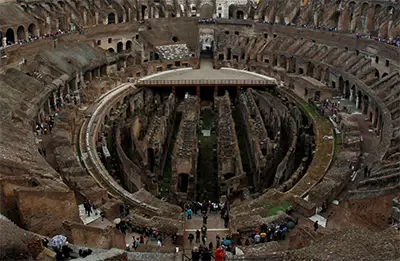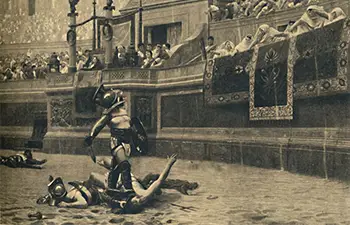|
Colosseum Refit to Restore Center Stage
May 1, 2021 Restoration is coming to the Colosseum. 
The most popular of landmarks in Rome (with an estimated 7.6 million visitors in 2019, the last pre-COVID-19 year), the Colosseum had, for many years, a showcase floor that covered underground chambers inhabited by gladiators and opponents waiting for their time in the arena. Archaeologists in the 19th Century removed that floor in order to excavate beneath it. Visitors today can stand nearly anywhere in the giant amphitheater and see the remains of those underground chambers. Roman officials, however, wanted a floor again and so launched a competition, which Italian engineering consulting company Milan Ingegneria won, and the result, after an expected price tag of 15 million euros (US$18 million), is planned to be a high-tech retractable floor. At its unveiling in 2023, the new floor is to be sustainable and easy to remove, should Colosseum officials want to showcase the entirety of what's underneath. Floor plans include a number of slats, through which viewers can glimpse the tunnels and chambers underneath while the floor is "closed." Significantly, the return of a floor in the center of the 60,000-seat amphitheater would facilitate the staging of plays or musical concerts that featured performers standing and sitting on a stage. The idea to replace the floor was not a new one, having been proposed several times in the past two centuries. A 25-million-euro restoration of the fabled monument in 2014 renewed the conversation for the floor replacement. 
The Colosseum, also known as the Flavian Amphitheater, dates to the 1st Century and was the largest structure of its kind in the world. Common forms of entertainment within the Colosseum's confines were gladiator challenges, man versus beast struggles, mock naval battles (for which the organizers used special channels to fill and then drain the floor of the structure), music and drama festivals. A total of 36 trapdoors were used for special effects, including the surprise appearance of new combatants. Some emperors also used the Colosseum as a forum for public executions. For events like animal hunts, organizers often decorated the floor of the arena with appropriate elements of setting, such as rocks and trees. |
|
Social Studies for Kids
copyright 2002–2024
David White




